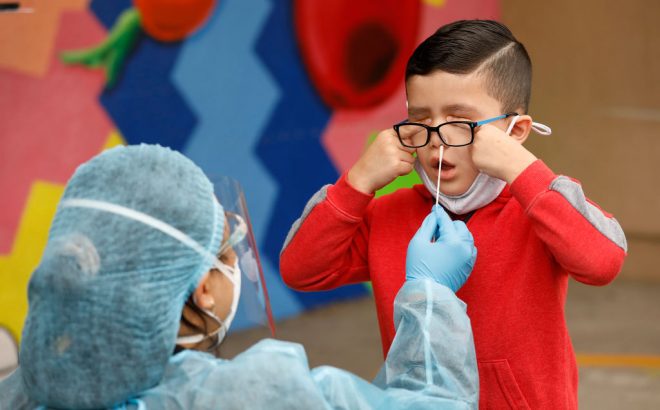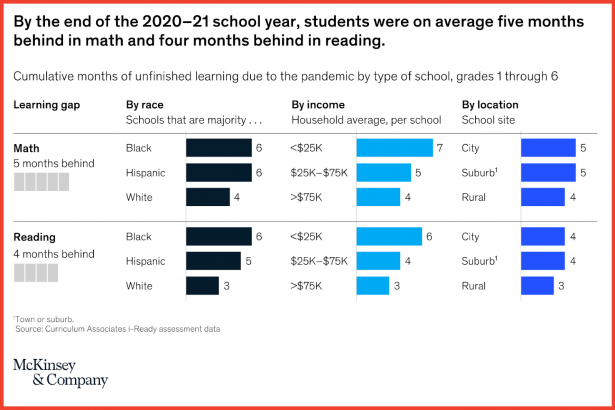The Week in COVID & Education Policy: COVID Testing Could Help Schools Stay Open Safely, Homeschooling Surges and 14 More Key Updates

This is our weekly briefing on how the pandemic is shaping schools and education policy, vetted, as always, by AEI Visiting Fellow John Bailey. Click here to see the full archive. Get this weekly roundup, as well as rolling daily updates, delivered straight to your inbox — sign up for The 74 Newsletter.
Implementing Routine COVID-19 Testing in Schools Can Significantly Reduce (and in Some Cases Eliminate) Transmission: New Mathematica report
- “Modeling showed routine and robust testing programs are highly effective at reducing within-school COVID-19 transmission, but most schools require considerable support from federal and state authorities, including detailed operational guidance, practical assistance and resources to navigate logistical, regulatory and procurement needs.”
- “Modeling also showed that pooled PCR (nose swab) testing is generally the most effective testing strategy for higher-risk schools relying on testing to reduce within-school transmission. Serial antigen testing is a close second.”
- “Community engagement and buy-in from key stakeholders are critical to the success of a testing program. Effective communication and simplified processes helped build and maintain trust in the program.”
- Related: How COVID-19 testing can keep students in school, via three doctors in The Boston Globe.
- Case study: 200 Schools, Universal Weekly COVID Screening: How ‘Assurance Testing’ Has Kept Thousands of Texas Students in Classrooms

July 30, 2021 — The Big Three
CDC Revises Mask Guidance: Just two weeks after the Centers for Disease Control and Prevention said it was safe for vaccinated individuals to be maskless in schools, they revised their guidance, recommending instead that vaccinated people wear masks in indoor, public settings if they are in areas of “substantial to high transmission.”
- CDC Director Dr. Rochelle Walensky said the revised masking guidance is based on “new data [showing] fully vaccinated people who are infected with Delta variant might be infectious & potentially spread COVID-19 to others.”
- The CDC defines “substantial transmission” as 50 to 100 cases per 100,000 people in a seven-day period and “high transmission” as more than 100 cases per 100,000. Based on that criteria, 46 percent of counties have “high transmission” and 17 percent have “substantial transmission.”
- President Joe Biden: “Today, the CDC also reaffirmed that we can safely reopen schools this fall — full time. Masking students is inconvenient, I know, but will allow them to learn and be with their classmates with the best available protection.”
- American Federation of Teachers: “Masking inside schools regardless of vaccine status is required as an important way to deal with the changing realities of virus transmission. It is a necessary precaution until children under 12 can receive a COVID vaccine and more Americans over 12 get vaccinated.”

More Research Quantifies COVID Learning Loss:
- Students fell four to five months behind during the pandemic, according to a new McKinsey report.
- “Students in majority Black schools ended the year with six months of unfinished learning, while students from low-income schools finished seven months behind.”
- “Unless steps are taken to address unfinished learning, today’s students may earn $49,000 to $61,000 less over their lifetime owing to the impact of the pandemic on their schooling.”
- Students made gains in 2020-21, but at a lower rate, a new NWEA report shows. (More from The New York Times)
- “Third-graders who attended a low-income school tested 17 percentile points lower in math this spring compared with similar students in 2019.”
- “Latino third-graders performed 17 percentile points lower in spring 2021 compared with the typical achievement of Latino third-graders in the spring of 2019. The decline was 15 percentile points for Black students.”
- “In one surprising finding, NWEA researchers found that students made some gains in the fall, but that the pace of learning stalled more significantly from winter to spring, even after many schools had returned in person.”
Homeschooling Surges, with Black Families Leading the Way: Via the Associated Press
- “Black households saw the largest jump; their homeschooling rate rose from 3.3 percent in the spring of 2020 to 16.1 percent in the fall.”
- “There’s no turning back for us now,” one parent said. “The pandemic has been a blessing — an opportunity to take ownership of our children’s education.”
- “For some families, the switch to homeschooling was influenced by their children’s special needs. That’s the case for Jennifer Osgood of Fairfax, Vermont, whose 7-year-old daughter Lily has Down syndrome. Having observed Lily’s progress with reading and arithmetic while at home during the pandemic, Osgood is convinced homeschooling is the best option for her going forward.”
Federal Updates
Infrastructure Deal: A bipartisan group of 10 negotiators reached agreement on a $1.2 trillion “hard infrastructure” package.
- The education provisions include support for electric vehicles and low-emission school buses. Plus $65 billion for broadband, which includes the Digital Equity Act.
- The Senate voted 67-22 Wednesday evening to move forward with the proposal.
- Read more: Details, White House Statement, a summary from Axios.
U.S. Education Department: Released a resource to help schools improve ventilation systems
$3 Billion in Investing in America’s Communities Grants: The Department of Commerce announced several competitive grants:
- Build Back Better Regional Challenge ($1 billion): Providing investment to 20 to 30 regions across the country to revitalize their economies.
- Good Jobs Challenge ($500 million): Will invest in building and strengthening regional workforce training systems and sector-based partnerships, with a focus on programs targeted at women, people of color and historically underserved communities.
- Indigenous Communities Challenge ($100 million): U.S. Economic Development Administration will work with tribal governments and indigenous communities to develop and execute the economic development projects they need to recover from the pandemic.
- Travel, Tourism and Outdoor Recreation Grants ($750 million): Competitive grants to further invest in infrastructure, workforce or other projects to support recovery and resilience in the communities hardest hit by disruptions in the travel, tourism and outdoor recreation sectors.
- Statewide Planning, Research and Networks Grants ($90 million): Investing in projects that will promote equity and develop local economies that will be resilient to future economic shocks and climate change.
City & State News
California:
- Gov. Gavin Newsom sent his kids to a summer camp not enforcing state mask rules. He pulled them out after one day.
- Two parents’ groups are suing Newsom over mask mandates in public schools.
Colorado: Department of Public Health and Environment released new COVID-19 guidelines for schools.
- Students, teachers and staff who are vaccinated will not have to wear masks at school and won’t have to quarantine if exposed to someone who is tested positive.
- Masks are recommended but not required.
- The department also shared an adolescent COVID-19 vaccination toolkit.
Illinois: Chicago Catholic Schools hires charter executive Greg Richmond as superintendent
Michigan: Detroit public schools, Detroit Federation of Teachers reach a reopening agreement that includes $2,000 hazard pay, a virtual learning option, testing for unvaccinated staff.
Texas:
- Margaret Spellings: STAAR test scores are alarming, but they can help us improve Texas schools. Here’s how.
- Houston ISD outlined its American Rescue Plan spending priorities, which include $135.91 million for a yearly $2,500 recruitment/retention stipend for teachers; $127.84 million on curriculum resources and professional development; $113.33 million for student interventions to address learning loss; $59.93 million for social-emotional learning and counselors; and $80 million for technology.
COVID-19 Research
Pfizer:
- The Biden administration purchased an additional 200 million doses “to prepare for future vaccination needs, including vaccines for children under 12 and possible booster shots if studies show they are necessary.”
- Australia’s health regulator, the Therapeutic Goods Administration, approved the vaccine for children ages 12 to 15.
- Pfizer released data showing that a third dose of its vaccine can “strongly” boost protection against the Delta variant — beyond the protection afforded by the standard two doses.
- Efficacy slips to 84 percent after six months. “If the vaccine’s efficacy continues to decline at the rate observed in the paper, it would fall below the 50 percent threshold — a benchmark for vaccine utility — within 18 months of vaccination.”
Moderna: European Medicines Agency approved the vaccine to be used in children ages 12 to 17.
- By the way: The Moderna vaccine is now called Spikevax in the European Union.
FDA asks Pfizer, Moderna to Expand Children’s Trials: The move is “intended to assess whether a rare inflammation of the heart muscle that has been seen in young adults shortly after vaccination is more common in younger age groups.”
- “A federal official who spoke on the condition of anonymity predicted that authorization of a coronavirus vaccine for children 5 through 11 might come by late October or early November.”
- “Moderna would likely seek authorization for the vaccine in “winter 2021/early 2022.”
A New Way to Visualize the Surge in COVID-19: Via STAT
- “As an analogy, a car’s velocity tells you how fast the car is going. Its acceleration tells you how quickly that car is speeding up.”
- STAT compiled data from several sources to calculate the rate of weekly case acceleration which helps provide a new indicator of how intense a wave might be and how long it might last.
- By looking at the state’s case acceleration rate, we can see that cases in Louisiana are currently increasing faster than they did at the start of last winter’s wave.
Parents Split on Vaccine for Children Under 11: Survey fromUniversity of Michigan’s C.S. Mott Children’s Hospital
- “49 percent of parents say it’s likely they will get their children vaccinated. 51 percent say it’s unlikely, even if approved by the FDA.”
- “Families with lower incomes are less likely to get the vaccine (38 percent likely to get the vaccine) than higher incomes (60 percent).”
- “Many parents report they have not discussed COVID vaccination with their child’s provider (50 percent older, 70 percent younger children).”
GOP Governors Call for Full Vaccine Approval: “As U.S. regulators weigh giving the final stamp of approval for certain COVID-19 vaccines, governors in states hard hit by the pandemic hope the move will help persuade the many holdouts in their states to finally get the shot,” the AP reports.
Vaccinations Prevented Up to 279,000 COVID-19 Deaths: Estimates a new Yale study.
mRNA Vaccinations vs. COVID-19 Risk in Teens – Vaccinations are Safer: Study out of Case Western Reserve University.
Viewpoints
School Disrupted: Parents say pandemic learning models will remain into the new school year, according to a new report from Tyton Partners (with support from the Walton Family Foundation).
- The adoption of supplemental learning pods is real – the percentage of parents enrolling their child is expected to expand next year.
- Parents report being highly satisfied with their decision to enroll their child in a supplemental learning pod, irrespective of their child’s core school.
- Parent satisfaction with alternative school models increased since the start of the pandemic and was higher than the satisfaction of parents whose child continued their pre-pandemic school arrangements
- Nearly all the parents who enrolled their child in a learning pod or microschool as a core school said they will continue with this model into the 2021-22 academic year
Feeling Uncertain and Unsettled: Great piece by Emily Oster.
The United States Prosperity Index 2021: Released by the Legatum Institute yesterday, the report provides a comprehensive picture of prosperity for the 50 states as well as the 1,196 counties in California, Colorado, Florida, Georgia, Iowa, Kentucky, Minnesota, Montana, Nebraska, New York, Oklahoma and Texas.
The Pandemic Drove Women Out of the Workforce. Will They Come Back?: A super long but worthwhile piece from Politico.
Guides for Elementary and Secondary School Emergency Relief Fund Spending, Scheduling and Staffing: A multitude of new resources with advice on what to do now and what to build toward.
5 Ways Principals Can Make Federal Relief Money Matter More for Their Students: Via the National Association of Elementary School Principals and Edunomics Lab.
…And on an Inspiring Note
Find People Who Cheer You On: The way Lydia Jacoby’s friends and family cheered her on to GOLD from Seward, Alaska.
ELECTRIC.
Relive the moment Lydia Jacoby’s friends and family cheered her on to GOLD from Seward, Alaska. #TokyoOlympics pic.twitter.com/jjLWAlaljy
— #TokyoOlympics (@NBCOlympics) July 27, 2021
ICYMI @The74
Weekend Reads: In case you missed them, our top five stories of the week:
- Summer Fun: Summer School, Reimagined — Tulsa Returns 11K Students to Campuses in July by Putting Fun Before Academics
- School Finance: Amid Historic Federal Windfall, School Leaders Find that Soaring Inflation is Curbing Their Ability to Purchase, Hire and Build
- Student Health: Ask the Doctor — With Delta Variant Rampant, How Can Parents Protect Young Kids from COVID this Summer and Fall?
- Learning Loss: Early Reading Skills See a Rebound From In-Person Learning, But Racial Gaps Have Grown Wider, Tests Show
- STEM: A Summer Rocket Program Launches Boston Girls Into the Next School Year
Disclosure: John Bailey is an adviser to the Walton Family Foundation, which provides financial support to The 74.
Help fund stories like this. Donate now!

;)
